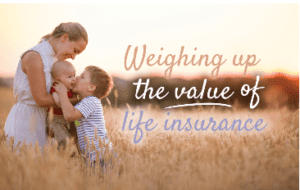WEIGHING UP THE VALUE OF LIFE INSURANCE
Posted on March 12, 2018
It probably comes as no surprise to anyone that there is a significant underinsurance gap between what we would need to maintain our standard of living should the unthinkable happen, and what we are actually covered for in the way of insurance.
Australia is one of the most underinsured nations in the developed world, ranking 16th for life insurance coverage.i
There are lots of reasons people give for not buying life insurance, but top of the list is invariably cost. Sounds reasonable enough, especially when households are under pressure from increasing costs of living. But dig a little deeper and it turns out the way we weigh up decisions when outcomes are uncertain is not always in our best interests.
According to something called ‘Prospect Theory’, people fear a certain loss more than they value a larger but uncertain gain. We tend to view money spent on insurance premiums as a loss, unlike money spent on a daily cup of coffee, a pair of shoes or a weekend away, which deliver immediate rewards.
There’s also a disconnect between what we say we value and what we spend our money on.
Thinking about the unthinkable
When asked, most people say the thing they value most is family. Yet when it comes to insurance many of us cover our car and our home but overlook our most important assets – our life, our ability to earn an income and the wellbeing of the people who depend on us.
Thinking about being diagnosed with a terminal disease, suffering a disabling accident or contemplating your own death or that of your partner is uncomfortable. Seeking cover for those possible eventualities is something that is very easy to put off or avoid altogether.
The real value of life insurance is the peace of mind, that if we die or become seriously ill and are unable to work then the right amount of money will go to the right people when they need it most.
Types of life insurance
There are different types of life insurance. Death cover provides a lump sum if you die or are diagnosed with a terminal illness. Total and permanent disability (TPD) pays a lump sum if you are permanently disabled due to an accident or illness and unable to work again. Trauma Insurance (critical illness insurance) pays a lump sum on the diagnosis of one of a list of specific illnesses such as a heart attack, cancer or a stroke. Income protection provides a monthly payment if you can’t work due to illness or injury.
The amount of life insurance you need depends on your family circumstances, your income and lifestyle. While many working Australians have default cover in their super fund, that’s no cause for complacency. It’s often a basic level of cover, which may need to be topped up outside super.
Take Chris, aged 30. He has a partner, two children and the median level of default life insurance cover in super for someone his age. That is, $211,000 in death cover, $162,500 for TPD and $2,250 a month for income protection. According to a recent report by Rice Warner, the amount someone in Chris’s position needs is closer to $704,000 of death cover, $910,000 of TPD cover and $4,150 a month of income protection.ii
Paying for peace of mind
Paying life insurance premiums won’t provide the instant pleasure hit of an espresso, but most people would be surprised to know that the peace of mind that comes from protecting their family’s financial security costs less than their daily cup of coffee.
Rice Warner estimates the cost of death cover and TPD cover for the average working Australian at less than 1 per cent of salary, and less than 0.5 per cent for white collar workers.iii Which begs the question, what cost do you put on the wellbeing of the people you love most?
If you would like us to help you work out the appropriate level of life insurance for your family, and the best way to achieve it, give us a call.
i Swiss Re Economic Research & Consulting, 2007
ii Underinsurance in Australia 2017, Rice Warner.
ii www.ricewarner.com/rice-warners-affordability-study-how-affordable-is-group-insurance-in-superannuation/
RECENT POSTS
Winter is here and we are almost to the end of another financial year. And what a year it’s been! With so many Australians impacted by fires, floods, drought and now COVID-19, let’s hope the new financial year sees a return to something like normality.
Australia’s economy stubbornly defied predictions during 2023, dashing any hopes that we might begin to return to some kind of normal.
Some had expected an end to the Reserve Bank’s continued cash rate rises during the year. Instead, inflation has been a stubborn foe and we saw five rate rises, adding another 1.25%. But there was good news for property investors with an increase in prices in some cities.
With interest rates at historic lows and likely to stay that way for some time, retirees and other investors who depend on income from their investments are on the lookout for a decent yield. Income from all the usual sources, such as term deposits and other fixed interest investments, have slowed to trickle. Which is why many investors are turning to Australian shares for their reliable dividend income and relatively high dividend yields.





